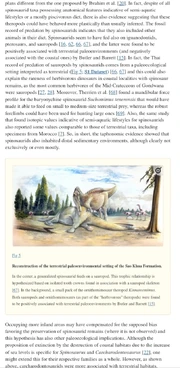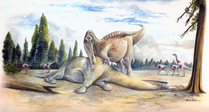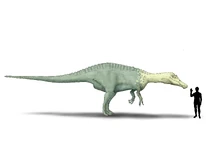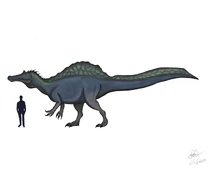Siamosaurus, meaning "Siamese lizard", (SIE-ah-moe-SORE-us) [1] is an extinct genus of medium sized spinosaurinae spinosaurid which existed during the early Cretaceous period[2], in south to southwest asia; territory that is now correlating to modern Thailand.[3][4][5][6] The exact size of this dinosaur is currently unknown, however most estimates suggest that it was around 9.1 metres to 9.5 meters (30 ft) in length and 2-3 tons in weight.[7]

Siamosaurus fusuiensis replica in a naturalistic environment. Credit: zoome3
Its teeth closely resembled those of its close-relative ( spinosaurinae ) species; like Spinosaurus aegypticus.[8][9][10] Its diet is one of the primary examples where the generalist carnivorous behavior of spinosaurids can be observed via direct fossil evidence. The opportunistic generalism and carnivory seems to be the case as some of the siasmosaurus remains found to be with the direct assosication with sauropod remains [11][12]
Habitat[]

The report about Spinosaurid generalist and carnivorous behavior; giving the example - amongst with many others - Siamosaurus direct consumption of Sauropods. As well as citing some Spinosaurids showing terrestrial isotope results. Research name: The “χ” of the Matter: Testing the Relationship between Paleoenvironments and Three Theropod Clades

( A ) Siamosaurus-suteethorni ( B ) Contemporary Spinosaurid teeth from same localities
According to a 2010 publication by Roman Amiot and his colleagues found that oxygen isotope ratios in spinosaurid remains likely suggest semiaquatic lifestyles. Further comparisons between spinosaurid teeth and those of a contemporary theropod, crocodile and turtle showed that they were more closer ( albeit not in the similar level ) to those of crocodilians and turtles than was originally believed, further supporting the notion that Siamosaurus and some species of spinosaurids were likely semi-aquatic.
- Siamosaurus specimens tend to have the largest difference to theropods and Spinosaurus had the smallest. The results of the tests concluded that some spinosaurids had lifestyles similar to crocodilians, pelicans, anacondas; some varanids, cormorants and hippopotamuses and spent most of their daily life in water and around water habitats; meanwhile others shown similar results and likely preferences to other regular, well known theropod species and genuses.

A very unique interpretation and illustration of Siamosaurus; with more extended tail vertabrae as well as with a more developed sail; akin to more later spinosaurinae such as Oxalaia & Spinosaurus. Credit: Wongwech Chowchuvech @JobSaurusRex
Its theorized or speculated that presumed semi-aquatic adaptations and habitat preference might suggests that Siamosaurus was able to live alongside; as well as, successfully coexist with other theropods without actually having to compete for more territory, since they lived in different habitats. This would have; however, has not been the apparent case; as original study suggested that Siamosaurs switched or interchanged between terrestrial to aquatic habitats; regularly.

Direct fossil evidence shows that Siamosaurus consumed sauropods. Whether its an entirely scavenging event amd/or predation - remains unclear. However the existence of these instances being more than one might give credence towards the latter theory.
Behavior[]
Despite the apparently most divergent and differentiated semi-aquatic results compared from studies; This particular Spinosaur; Spinosaurinae itself likely had more terrestrial prey items in its diet; as clearly indicated by several sauropod remains in direct association with Siamosaurus itself! [13][14][15][12]
Thus; it would be in direct competition for; at the very least prey items for other theropods - if they existed within its habitat; at all - south to southeast asian range.[16][17][18][19][20]

Siamosaurus suteethorni illustration. Credit: hyrotrioskjan ( its unclear if it had the enlarged tail vertebrae )

PNSO siamosaurus Replica / Model. Credit: acrosaurotaurus
Siamosaurus and Ichthyovenator are the two primary spinosaurid species that live in south to southeast Asia. How they migrated there or why they lived there is unknown. There seems to be no clearly identifiable or observable advantages living there, other than the apparent lack of competition with other, larger spinosaurids as well as other larger theropods; and other large carnivores like giant crocodylimorphs.
Both species likely existed as the largest known theropods and generalist carnivores in their habitats likely because of this '' migration ''.
Other Wikis[]
References[]
- ↑ Buffetaut, E.; and Ingevat, R. (1986). Unusual theropod dinosaur teeth from the Upper Jurassic of Phu Wiang, northeastern Thailand. Rev. Paleobiol. 5: 217-220.
- ↑ https://www.semanticscholar.org/paper/An-early-spinosaurid-dinosaur-from-the-Late-of-and-Buffetaut/5d238b7b57c9810200bae030b9f21bb601c3f87c
- ↑ https://a-dinosaur-a-day.com/post/184424598140/siamosaurus-suteethorni
- ↑ https://eurekamag.com/research/020/549/020549923.php
- ↑ https://www.sciencedirect.com/science/article/abs/pii/S0031018299000048
- ↑ https://www.researchgate.net/publication/312976683_The_dinosaur_fauna_from_the_Khok_Kruat_Formation_Early_Cretaceous_of_Thailand
- ↑ https://www.encyklopedia.dinozaury.com/wiki/Siamosaurus
- ↑ https://www.researchgate.net/figure/Spinosaurid-teeth-A-Siamosaurus-suteethorni-holotype-Thailand-Sao-Khua-Formation_fig2_235679976
- ↑ http://www.fossilworks.org/cgi-bin/bridge.pl?a=taxonInfo&taxon_no=56419
- ↑ https://www.paleo-passion.com/en/dinosaures/3704-siamosaurus-suteethorni.html
- ↑ https://journals.plos.org/plosone/article?id=10.1371/journal.pone.0147031
- ↑ 12.0 12.1 https://www.ncbi.nlm.nih.gov/pmc/articles/PMC4734717/
- ↑ https://journals.plos.org/plosone/article?id=10.1371/journal.pone.0152634
- ↑ https://www.readcube.com/articles/10.1371/journal.pone.0147031
- ↑ https://dbpedia.org/page/Siamosaurus
- ↑ https://dinosaurpictures.org/Siamosaurus-pictures
- ↑ https://li01.tci-thaijo.org/index.php/tnh/article/view/181194
- ↑ https://www.researchgate.net/publication/249552008_Palynology_and_stratigraphy_of_the_Mesozoic_Khorat_Group_red_bed_sequences_from_Thailand
- ↑ https://pubs.geoscienceworld.org/sgf/bsgf/article-abstract/173/5/415/88325/a-new-specimen-of-spinosaurus-dinosauria-theropoda
- ↑ https://www.academia.edu/395353/The_Dinosaur_Fauna_from_the_Khok_Kruat_Formation_Early_Cretaceous_of_Thailand
